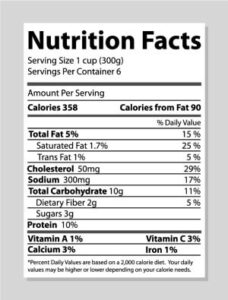1. The first place to look on a label is the serving size and the number of servings in the package. It is not like food manufacturers are out to trick you but sometimes foods labeled “low calorie” are only low calorie if a quarter of a package is consumed, not the entire package. Serving sizes are standardized to make it easier to compare similar foods.
2. The next place your eye should go is the calories part of the label. For people trying to lose weight by counting and restricting calories this is particularly important. An important component here is calories from fat. A healthy diet would have less than 30% of calories from fat. That’s a good place to start when thinking of how to interpret calories and calories from fat.
3. Next step is to identify the bad ingredients such as trans fat, saturated fat and sodium (1). As a reminder, there are good or healthy fats (such as omega 3) and bad, or saturated fats. This must be listed on a nutrition label in the United States. The idea is to limit bad fats, sodium (salt), and carbohydrates. The American Heart Association recommends no more than 2,300 milligrams (mg) of sodium a day and moving toward an ideal limit of no more than 1,500 mg per day for most adults (2). Foods that tend to be high in sodium include highly processed meats such as pepperoni and many frozen pre-packaged meals.
4. Identify things in the food you want to consume more of in your diet such as iron, protein, calcium and vitamin C.
5. Now you get a little more particular about what to read on the nutrition label. Sugar alcohols are featured on food labels as well. Sugar alcohols are often used as an alternative to sugar as a sweetener because they provide sweetness without a lot of calories and don’t raise blood sugars as quickly as table sugar. Some examples of sugar alcohols include sorbitol, mannitol, and xylitol. Added sugars are listed on your label, and should generally be limited, depending on the food. For example, look for yogurt with low sugar where you can, as some yogurts add a lot of additional sugars and may appear healthy from just the bold product label front. Consider foods with under 9 g of added sugars where possible. Vitamins and minerals are also found on product labels and are generally seen as a percentage of daily requirements based on a standard 2,000 calorie diet plan. It is important to try to get 30-50% of these daily requirements per meal.
6. When checking food labels remember to consider any food allergies you or anyone consuming the food may have. Peanut allergies are common, for example, and some foods may contain peanuts that may not be apparent at first glance.

Step 1: Start with the Serving Size
Step 2: Check Out the Total Calories
Step 3: Let the Percent Daily Values Be a Guide
Step 4: Check Out the Nutrition Terms
Step 5: Choose Low in Saturated Fat, added Sugars and Sodium.
1 https://www.cdc.gov/salt/ research_reviews/sodium_ potassium_blood_pressure.htm
DAR-0144 RevA 01/2020